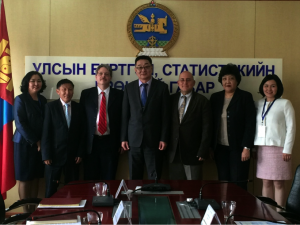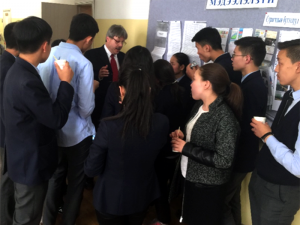Recent Statistics and Operations Research Events in Mongolia
James Cochran
During the week of May 23, the National Registration and Statistics Office of Mongolia (NRSO) and the National University of Mongolia (NUM) co-hosted a series of events under the theme “Applied Statistics: Teaching, Research, and Business Innovation.” The events were organized jointly with professors from the University of Alabama, Yale University, and Penn State University. The initiatives of these American professors were designed to help Mongolian schools teach their students basic statistics and operations research, as well as introduce them to career opportunities in these professions.

From left: Altantsetseg Sodnomtseren, Demberel Ayush, James J. Cochran, Mendsaikhan Sonomtseren, Edward H. Kaplan, Oyunchimeg Dandar, and Ganchimeg Mijiddorj meet at the National Registration and Statistics Office of Mongolia.
On May 24, a full-day workshop titled Basic Operations Research for Statisticians was held at the National University of Mongolia. The workshop was comprised of the following two sessions:
- Introduction to Linear Programming for Statisticians: In the morning session, Cochran, of the University of Alabama, led a discussion about the basics of linear programming. Participants were exposed to a variety of concepts, including problem formulation, sensitivity analysis, and interpretation of solutions. Extension of linear programming to integer programming also was discussed. Active learning exercises were demonstrated throughout this session, and participants learned how to use the Excel-based software Solver to find the optimal solution and perform sensitivity analysis for linear and integer programming problems.
- Stochastic/Probabilistic Models: In the afternoon session, Kaplan, professor at Yale and president of INFORMS, gave myriad examples of stochastic modeling in operations research. Topics included random incidence, Markov chains, and Little’s Theorem and queuing theory. Excel and the freely available Queuing ToolPak add-in were used to support the numerical calculations. Applications included why your friends have more friends than you do, how just missing a bus can reduce your expected waiting time, staffing service systems, cancer progression, cyber-terrorism, blood banking, managing a prison system, and estimating the size of hidden queues such as undetected HIV infections or undetected terror plots.
More than 80 participants from Mongolian universities and businesses participated in the workshop.
On May 25, Cochran and Penn State University Professor James L. Rosenberger led the half-day workshop Introducing Statistics into the High-School Mathematics Curriculum. High-school mathematics teachers learned ways they could integrate basic probability and statistics concepts into their algebra, geometry, and calculus courses and develop statistics courses at a level that is appropriate for high-school students. Participants also learned about topics that can be covered, logical orders in which they can be covered, and the relationships between some core high-school mathematics concepts and concepts in statistics and probability. More than 100 mathematics teachers from secondary schools participated in the workshop.
During the afternoon of May 25, Cochran also taught a class of 30 11th-year secondary school students several basic statistics concepts—including measures of location, measures of variation, and effective visualization—using a case he wrote and has used in his introductory statistics courses. Several high-school mathematics teachers, college mathematics and education instructors, and officials of Mongolia’s NRSO and Ministry of Education, Culture, and Science observed this 90-minute session.
After the session, everyone participated in a group discussion led by Cochran. They talked about the importance of statistics in a high-school curriculum, the experience of learning and teaching using a case, and issues that can arise when implementing the case teaching method into Mongolian high schools. The students were enthusiastic about their experience with the case and the case method—they all enjoyed the challenges associated with working on an open-ended problem for which there were several potentially correct answers and the opportunity to discuss and justify their answers. The teachers and instructors were intrigued by the case methodology and appreciated the opportunity to observe the demonstration of a teaching method not common to Mongolia; however, a few did express concern about finding or developing cases and developing the classroom skills needed to teach using the case method.
The events of the week culminated with the international conference Applied Statistics: Teaching, Research, and Business Innovation on May 26. This conference aimed to provide a forum for academics, practitioners, government officials, and researchers to share ideas about recent developments in and applications of statistics, operations research, management science, and other related disciplines. The conference, which was attended by several diplomats, also fostered networking among the conference participants in the core areas of statistics, operations management, management science, mathematics, and ICT.
Faculty members and researchers from several universities and colleges—including the National University of Mongolia, Mongolian Education University, State of University of Life Sciences, and Institute of Finance and Economics—participated in the conference. Several representatives of state organizations (e.g., NRSO, Mongol Bank, Ministry of Finance), research organizations, and industry practitioners also presented their research at the conference.
These events will help the NRSO; Ministry of Education, Culture, and Science; and universities in Mongolia proceed with their efforts to quickly improve Mongolian students’ understanding and ability to apply basic statistics and operations research to problems in commerce and society. Also, the extensive coverage of the events by the Mongolian media—internet, television, and newspapers—will help the population better understand the objectives of this initiative. Finally, these events helped the American professors establish a strong network of university faculty, graduate students, high-school teachers, business people, and government officials with a common interest—improving Mongolian students’ understanding and ability to apply statistics and operations research.
Plans are underway to work with colleagues in the United States to organize and fund a workshop at the University of Alabama next summer. The plan is for approximately 20 instructors from Mongolian universities to travel to the campus to receive one to two weeks of instruction for teaching basic applied statistics from several well-respected U.S. statistics instructors. These participants also will receive textbooks and all material used in the workshop so they can prepare to give the same workshop at their home institutions in Mongolia (with the U.S. instructors’ assistance) and act as mentors for their colleagues in the summer of 2018. A similar workshop for operations research also may take place during the summers of 2018 and 2019. In this way, Mongolia will build its own statistics capacity and its students’ understanding and ability to apply statistics and operations research will improve greatly.
Education in Mongolia
Mongolia is a sparsely populated country bordered on its north by the Russian Federation and its south by the People’s Republic of China. The country is comprised of great plains, steppes, and rolling hills, as well as several mountain ranges and lakes—both fresh and salt water—that cover nearly 604,000 square miles, making it the 19th-largest nation in the world. On the other hand, its population of approximately 3 million makes Mongolia the 138th-most-populated nation in the world. Approximately 32% of Mongolia’s approximately 3 million people live in rural areas, and the majority of the rural population is composed of nomadic pastoralists.These characteristics create tremendous challenges for Mongolia’s education system, but the system meets them well—Mongolia’s 98.3% literacy rate is one of the highest in the world. The number of pupils and students at Mongolian educational institutions of all levels reached 742,000 in the 2015–2016 academic year. And in recent years, considerable progress has been achieved in the education sector, including improving school infrastructure, making schools more child friendly, and shifting to a competence-based curriculum. These objectives have been achieved while Mongolia has simultaneously brought down its school drop-out for children aged 6–15; for example, the rate dropped from 0.8 in the 2010–2011 academic year to 0.7 in the 2011–2012 academic year.
Since 2011, the government of Mongolia has introduced several primary and secondary education reform policies to advance the quality of education service. One of the focal points of these reforms is to increase the numeracy of Mongolia’s youth, particularly their ability to apply mathematical methods to real problems. It should be noted that, in Mongolia, statistics and operations research are not taught in high schools and are taught sporadically in universities. Hence, students lack necessary applied mathematics skills, and this lack of exposure (particularly with regard to statistics) puts Mongolia’s high-school students at a competitive disadvantage when they apply for admission to undergraduate programs with universities in the United States and other developed countries. Therefore, it is paramount to the nation’s development that establishing secondary-school statistics education programs, creating and maintaining support resources, and building statistics education capacity are components of school curriculum reform in Mongolia.


















